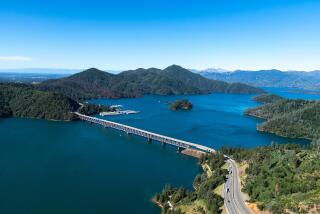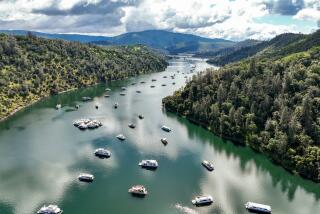Wet December brings nearly double the snowpack
- Share via
Helped by one of the wettest Decembers in history, California’s mountain snowpack is 198% of normal, the state Department of Water Resources said Tuesday.
“Hydrologically, we’re off to what promises to be a very good water supply year,” said Ted Thomas, a spokesman for the Department of Water Resources. “This is the best early water supply start since 2006.”
“This boosts our hopes that we will have an adequate water supply for our cities and farms as we continue to shake off effects of the 2007-09 drought,” Mark Cowin, director of the Department of Water Resources, said in a statement.
According to the agency, Pyramid Lake is at 98% of total capacity, and Castaic Lake is at 90%. Both reservoirs in northern Los Angeles County are at above-average levels for this time of year.
The rains also helped fill reservoirs in Northern California, which are key to the State Water Project, which in turn is critical to supplying the Southland’s water needs. Lake Oroville, the water project’s principal reservoir, is at 59% of capacity, which is just shy of being average for this time of year.
Reservoir levels at one of the Metropolitan Water District’s most important reservoirs, Diamond Valley Lake outside Hemet, are also on the rise. The reservoir, critical to Orange, Riverside and San Diego counties, is now more than 75% full — the highest it has been since January 2008, said Bob Muir, spokesman for the water district. Diamond Valley Lake was less than half full earlier this year.
Southland water reserves had been dwindling since 2007, Muir said, the result of dry rainy seasons and restrictions on pumping water out of the Sacramento-San Joaquin Delta to southbound aqueducts.
The reservoirs and the snowpack should get more help from the rainstorm that was expected to arrive Tuesday night in Southern California. The storm was expected to move through the area relatively quickly, but forecasters warned of low temperatures and plunging snow levels.
“It’s a fast-mover,” said Stuart Seto, a weather specialist with the National Weather Service. “It’ll last about 24 hours, with major rains out in six hours.”
Seto said about half an inch of rain on the coast and about 1 inch in the mountains was expected, with heavy rain moving in about midnight and lasting four to six hours.
The showers should end Wednesday afternoon. Winds could reach 15 mph to 25 mph during the day, increasing to 50 mph Wednesday night. Seto said the winds could prove particularly problematic because trees are more likely to blow over because of the soft ground.
This storm will be much colder than the previous systems, with temperatures in the mid-50s Thursday and Friday and lows down to 40 degrees overnight.
“This one comes from the Arctic and it brings that cold air with it,” Seto said.
By Wednesday night, snow levels could fall to as low as 2,000 feet. Snow could fall on Interstate 5 over the Grapevine and possibly on the 14 Freeway at Soledad Canyon, Seto said.
Even if there isn’t snow on highways and streets, motorists should prepare for icy conditions with the incoming rain freezing on some roads.
Forecasters predicted mostly cloudy skies above Pasadena on Jan. 1 for the Rose Parade. The low in Pasadena on New Year’s morning could be 41 degrees, and the high is expected to be only 56, said Bonnie Bartling, a specialist for the National Weather Service in Oxnard.
Bartling said there is a 15% chance that it will rain on the Rose Parade, but it seems more likely that Saturday’s expected storm will arrive many hours after the parade.
More to Read
Sign up for Essential California
The most important California stories and recommendations in your inbox every morning.
You may occasionally receive promotional content from the Los Angeles Times.











